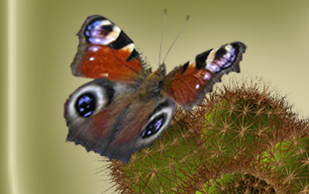Diary of the traveller.
Eugeny Safronov
The Southwest USA
Part 3
So then, we reached Big Bend National Park at 16 PM. (Point H)
** Big Bend National Park is placed in Texas . It was founded on 01.07 1944. It's border with Mexico is 393 km long and it occupies an area of 3242 sq. km. Big Bend is famous for its natural resources and spectacular geology. The park is home to more than 1,200 species of plants (including approximately 60 cacti species), 11 species of amphibians, 56 species of reptiles, 40 species of fish, 75 species of mammals, 450 species of birds, and about 3,600 species of insects. Big Bend was named after the bend of the border (brow) between USA and Mexico here. And Rio Grande river is a natural border here .**
It is + 43 C outside! It's terrible!
After 17 miles we reached Chisos Basin , the rocky valley, where we would spend two nights. The local rangers checked our fee for our stay. By the way, you can pay by the point of sale device located along the road. The check you must place in a definite place. Visitor Center , Commemorative picture.
We began our work in the morning. Big Bend must have many nice Horizontalonus, to my mind. We started looking for them. Point 284 – no Horizontalonus, but there were ECHINOCEREUS coccineus, stramineus, aff lionensis, LEPIDOCORYPHANTHA macromeris, ECHINOMASTUS warnockii, OPUNTIA. OPUNTIA spec. RUS 284
We moved far, found some Horizontalonus, but few. Point 285.
ECHINOCACTUS horizonthalonius RUS 285
Of course, we couldn't forget about showplaces. Santa Elena canyon.
Magnificent view. All southern park border that is, at the same time the border of USA , spreads along Rio Grande . One shore is in the USA , another in Mexico . And we saw no border patrols at all. Shonuff! The Mexican shore looks like a plumb wall 500- 600 m high along the entire length. No one way, nor another!
We mapped out some promising point further but the road was cordoned off by the poster: No passage! Road under repair! We had to stop nearby. Point 286. The chic Opuntia macrocentra v.minor.
Then we moved along the border to Glenn Spring . Point 287.
ECHINOCEREUS chisoensis RUS 287
CYLINDROPUNTHIA imbricata RUS 287
Our Boss (Igor Drab) pressed us to come to San Vicente. And for a reason. The view impressively changed and became light gray. The sheer gypsum around us. Point 288. 18 PM , strong wind and + 40C . We found a lot of tiny Horisontalonus. We saw plants with dualized and tripled central spins. There were many seeds!
ECHINOCACTUS horizonthalonius RUS 288
Many other cactuses, tiny A. fissuratus, Ep.bokei. ARIOCARPUS fissuratus RUS 288
EPITHELANTHA bokei RUS 288
It was late and we returned to the camp. Out tents were on-site, but we forgot about fuel. The oil detector showed that we had fuel for 40 miles but we were to go 45. It was only one petrol station in the camp and it was late evening then. We arrived to the fuel station but it was closed. We were sure that we couldn't return to the camp and come here in the morning again. We had not enough fuel. Good thing that rangers exist! They followed us to the fuel station in the morning. And we had enough fuel to get there!
As we had not enjoyed the point 288 on the previous day we decided to visit that place again. We had seen many nice plants last evening there. Point 289. More seeds and chic E.stramineus.
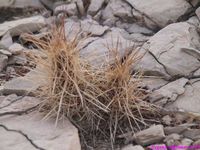
ECHINOCEREUS stramineus
RUS 289 |
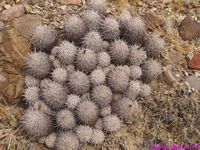
CORYPHANTHA
echinus
RUS 289 |
ECHINOCACTUS horizonthalonius RUS 289
We had to move further, backward to the exit from the park. But it was impossible to pass by cactuses! We stopped over, point 290. ECHINOCACTUS horizonthalonius RUS 290
And gopher like ECHINOCEREUS dasyacanthus (RUS290 )
Farewell Big Bend , or, may be Good by, you never know! We were to reach point I of our trip. We stopped before Marathon after 45 miles . Point 291. We found the wire fence along the road. It was supplied with posters (private premises), but they said there would be THELOCACTUS bicolor v. Flavidispinus. Some tension was in the air, we had to vamoose!
THELOCACTUS bicolor v. flavidispinus RUS 291
We passed a kilometer to the north. The same wire and the private premises. But there was a small zone 2- 3 m width along the road! There were Horizontalonuses, but short. And I saw many plants at the other side of the wire, and we need seeds! Heh! Point 292. ECHINOCACTUS horizonthalonius RUS 292
ECHINOCEREUS dasyacanthus RUS 292
We moved to the north. We made a short inspection near Fort Stockton , but nothing new. Point 291. We had to win 70 miles to reach our overnight stop.
If you decided to spend the night outside, you'll be need such a device as the ear plugs here. There are many noises that are not comfortable for our “urbanistic ears”. They can sink you at vigilance. That night we couldn't sleep because of oil-derricks, that pumped oil without a pause. We were in Texas ! Stick into the earth and you'll get the oil! Point 294.
We had a light breakfast in the morning and went to North-West. The first point was after 20 miles and we found a nice Homalocephala.
HOMALOCEPHALA texensis RUS 295
Once again we were looking for plants. We found a few plants and a half of them were dead. They couldn't survive last winter. There were some nice horizontalonuses found. There were three leftover fruits on one of the homalocephala…
We are going on. Igor Drab saw some marvelous Echinocereus fendlerii last year at that point and they were in flowers. But we saw nothing by the same reason – the plants had not outlasted the stern winter. But we found many small nice horizontalonuses for our pains! And with very good spines! We found some homalocephales there too. Point 296.
HOMALOCEPHALA texensis RUS 296
We reached New Mexico State . Point J on the map.
We noticed the great expand of variety of plants at our first stop in New Mexico . Point 297.
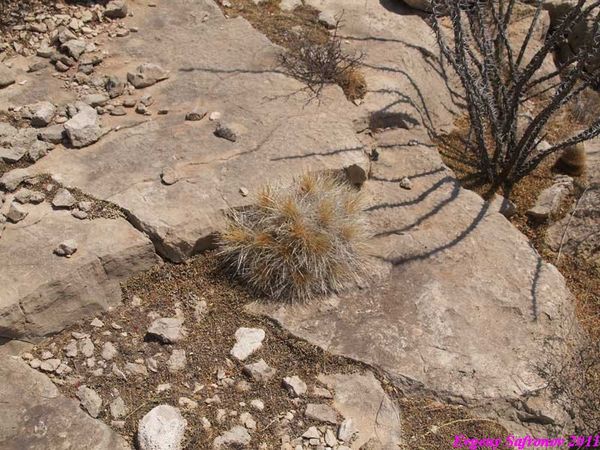
ECHINOCEREUS enneacantus
RUS 297 |
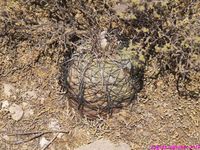
ECHINOCACTUS
horizonthalonius
RUS 297 |
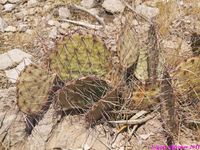
OPUNTIA
procumbens
RUS 297 |
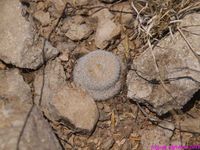
EPITHELANTHA
bokei
RUS 297 |
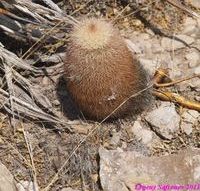
ECHINOCEREUS
dasyacanthus
RUS 297 |
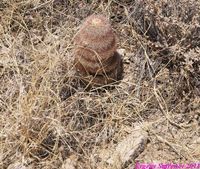
ECHINOCEREUS
dasyacanthus
RUS 297 |
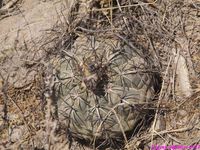
ECHINOCACTUS
horizonthalonius
RUS 297 |
We moved to the National Park Carlsbad Cavern NP .
** National Monument Carlsbad Cavern NP (est. 25.10.1923) – the National Park in Guadeloupe Mountains at South-East of New Mexico . USA . It was renamed to Carlsbad Caverns National Park on 14.05.1930. The park was included into the National Register of Historic Places. The main item of interest there are more then 300 limestone caves. **
Our aim was to see Escobaria minima (nelliae). But never believe if anybody tells you that it is growing here! You could never find it! Or you'd spend too much time! You could find it only by chance, or on a tip, as we did it. Point 298.
ESCOBARIA minima (nelliae) RUS 298
We spent the night near the Park. The air was filled by expectation of aliens. Everybody is waiting for them here, somebody says, they saw them… Keep away, devildom!
We hit the road again at the morning. There were many yuccas, agaves and cilindropunties in blossom. We made a stop, snapped photos and went on.
White Sands National Monument is a stand-alone story. We'd get back to cactuses later, but only white sand and struggling for life plants surrounded us. And it was not the usual sand but crystallized gypsum. The valley is the bottom of the lake with great amount of chalkstone. The rare rains dissolve the gypsum. The gypsum dries up in time and crystallizes. The wind moves the dunes and the “sand” covers the plants.
It's pity that we arrived there in day-time. Only in full moon, at midnight or at sunset you can make the best, original photos.
We left sands exhausted quite enough. We found large Echinocereus gonacanthus with huge spins nearby. They had many fruits but the seeds were not mellow because the plants had flowered not long ago. ECHINOCEREUS gonacanthus RUS 300
Rio Ranco was our next goal. Richard Kalas lives at that town, the Czech specialist in cactuses, who immigrated to USA in early 80. But the road passed by Belen, the place, where the Mesa Garden is located, the ‘Motherlend of cacti care”. Of course, we couldn't drive by Steven Brack. We had no exact address, however, and it's was strange that no one of local citizens could inform us about it. We decided to visit Steven Brack tomorrow together with Richard Kalas.
Richard Kalas is studying cactuses, systematic of the genus Echinocactus and writes articles to Cacti magazines. But it's his hobby. Не makes money by blacksmithing! He can forge, run, cut and weld metal, and he paints his products. He made cactuses from cooper and painted them! It's difficult to name his native cactuses a collection, but some plants are very interesting. There are many horizontalonuses and homalocephaloses in his yard, growing in buckets and a nice local blossoming opuntia.
We made some stops on our way to Steven Brack last day. Point 304.
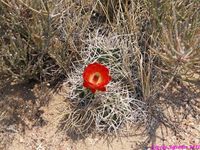
ECHINOCEREUS
gonacanthus
RUS 304 |
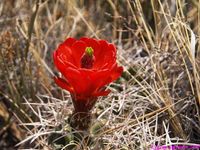
ECHINOCEREUS
gonacanthus
RUS 304 |
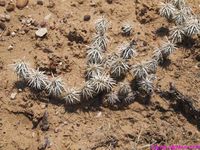
CORYNOPUNTIA
clavata
RUS 304 |
Now our way was to Belen. There were MacDonalds, Pizza Hat, some small shops – everything as in each small American town. There was a post office too, where we tried to recognize Stewen Brack's address, but couldn't find the stuff… We hardly could find Mesa Garden without Richard Kalas! Though it's not the center of Belen, but it is Mesa Garden ! Somebody should know!
November 2011.
To be continued...
|
